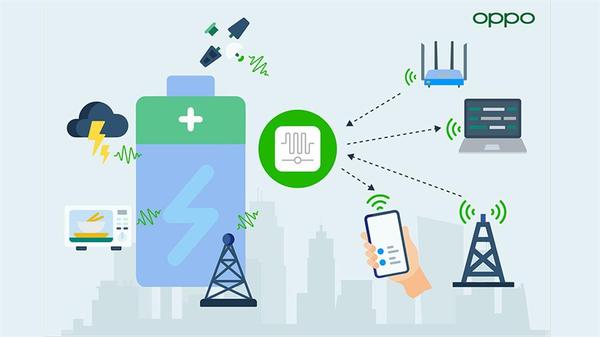Can you imagine a world without batteries?Zero-Power technology is already here
Most of today's portable electronic devices rely on batteries for power. Although batteries have come a long way of improvements and innovations over the years, they still show major drawbacks such as size, cost of production, service life, ease of use, and environmental friendliness. Zero-Power Communication technology avoids the need to use batteries, being able to collect and transform ambient radio frequency energy from its environment, which will result in very compact, more efficient and low-cost equipment. These properties will represent a great innovation for portable devices, as well as for smart homes, and will generate significant commercial benefits, as well as in logistics, storage, agriculture...
"From the first to the fourth generation of mobile telecommunications technology, the industry has gone through four technological leaps: from analog to digital, to data, and finally to broadband. Each of these leaps has been designed to offer faster data transmission speeds, however, for the next decade, considering 5G technology and even beyond, we do not believe that data transmission is as important a factor, rather we believe that telecommunications technology must evolve to deliver greater convenience and sustainable value to society.Zero-Power Communications technology offers a means for electronic equipment manufacturers to eliminate batteries from their products, thereby reducing costs and environmental impact.Therefore , Zero-Power Communications is one of our main focuses in moving towards the B5G/6G generation," said Henry Tang, Chief 5G Scientist at OPPO.
Although passive communication technology already exists today through Radio Frequency Identification (RFID) technology, current technology presents problems such as short communication distances, low efficiency, or limited system capacity. This means that there is a big challenge on how to apply RFID technology to more specific or complex developments, such as industrial sensor networks, low-cost, high-capacity storage and logistics, low-cost, low-energy smart homes, and even how to make portable technology possible in miniature.

Unlike the traditional method, Zero-Power devices can collect environmental radio signals emitted from points such as TV towers, FM radio towers, cellular base stations and WiFi access points (APs) as their power source. After harvesting energy from existing radio waves, the device can modulate ambient radio signals with its own information and transmit these signals outward in a process known as backscatter. When designing Zero-Power Communication networks, it will be necessary to consider their coexistence with currently existing 4G/5G communication systems.
Zero-Power Communication systems may be built in an environment that uses mobile communications, sidelink communications or both in a hybrid manner. Systems based on mobile communications are best suited to support industrial sensor network applications, for example, applications where devices are likely to work in extreme environments, where the number of devices on a network is large, or where the cost Deployment and maintenance costs of using traditional active devices are high. On the other hand, the sidelink-based approach is more suitable for low-cost, short-range communications, such as portable devices or smart home devices, where the equipment can also be used to receive and process data. A hybrid approach using both cellular and sidelink communication methods will allow developers to envision more applications, uses, and benefits using Zero-Power Communication systems.
How do I unlock a bike with a keypad? Here is a short ‘how-to’ clipPunch in your numbers, wait for the green light… https://t.co/T6pKXIipRA
— Tugo Bike Share Sat Jan 06 15:37:58 +0000 2018
OPPO has successfully built its own Zero-Power communication system, demonstrating the feasibility of the concept as a possible approach for future communication networks
OPPO, the world's leading brand of smart devices, officially presents its new Zero-Power Communication report conducted by the OPPO Research Institute. The company addresses the technical positioning of Zero-Power technology within the IoT space while showing the roadmap for future technological development in which different communication systems coexist.
In the near future, IoT devices will be able to charge through Bluetooth, WiFi and mobile phone signals, which will bring about a big change in the characteristics of the devices, making them smaller, longer lasting and cost lower, the number of used and discarded batteries will be significantly reduced. On the other hand, endangered migratory birds may be equipped with long-distance tracking equipment, these are some of the futuristic scenes shown in OPPO's "Zero-Power Communication" report.
OPPO has successfully built its own Zero-Power communication system, demonstrating the feasibility of the concept as a possible approach for future communication networks. In addition to this innovation itself, OPPO has also taken the initiative to create and promote the Zero-Power Communication standard, including proposing Zero-Power Communication research projects to 3GPP and presenting breakthroughs and findings during major conferences of industry such as FuTURE and ICCC. At the IMT-2030 6G Vision workshop in September 2021, OPPO hosted a Zero-Power Communication Forum, inviting industry and academic institutions to discuss possible applications, what technical requirements, and what technologies will be key to its development. . As the industry moves towards 6G, OPPO believes that Zero-Power Communication will work with other core technologies such as reconfigurable smart surfaces, symbiotic radio, non-orthogonal multiple access (NOMA) and artificial intelligence to take advantage of it. to all the potential that 6G will offer us.
Prior to the Zero-Power Communication report, OPPO has also introduced 6G AI-Cube Intelligent Networking, as an example of its continuous research towards cutting-edge technologies. In line with the company's mission of creating "for mankind, good for the world", OPPO aims to launch Zero-Power Communication technology in the next 3-5 years as it continues to build more intelligent communication systems. , more efficient and ecological.
